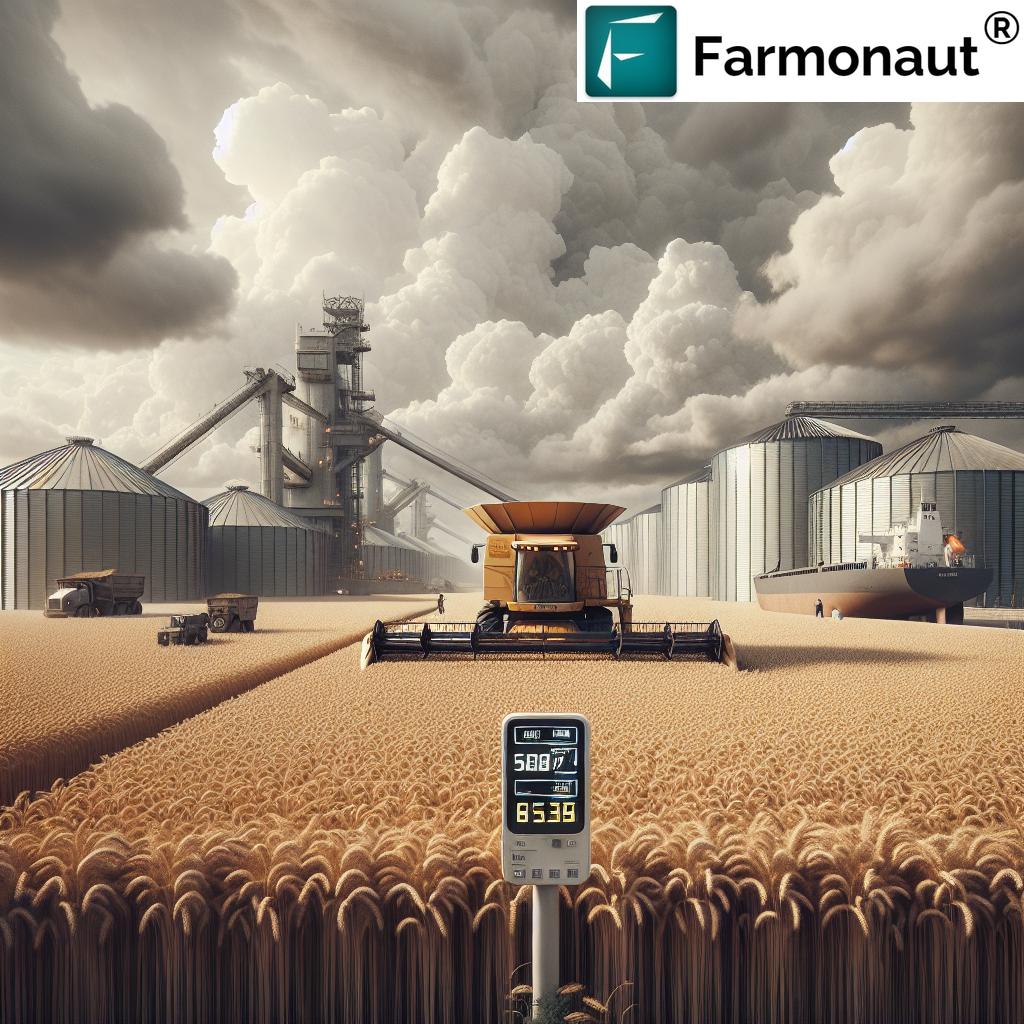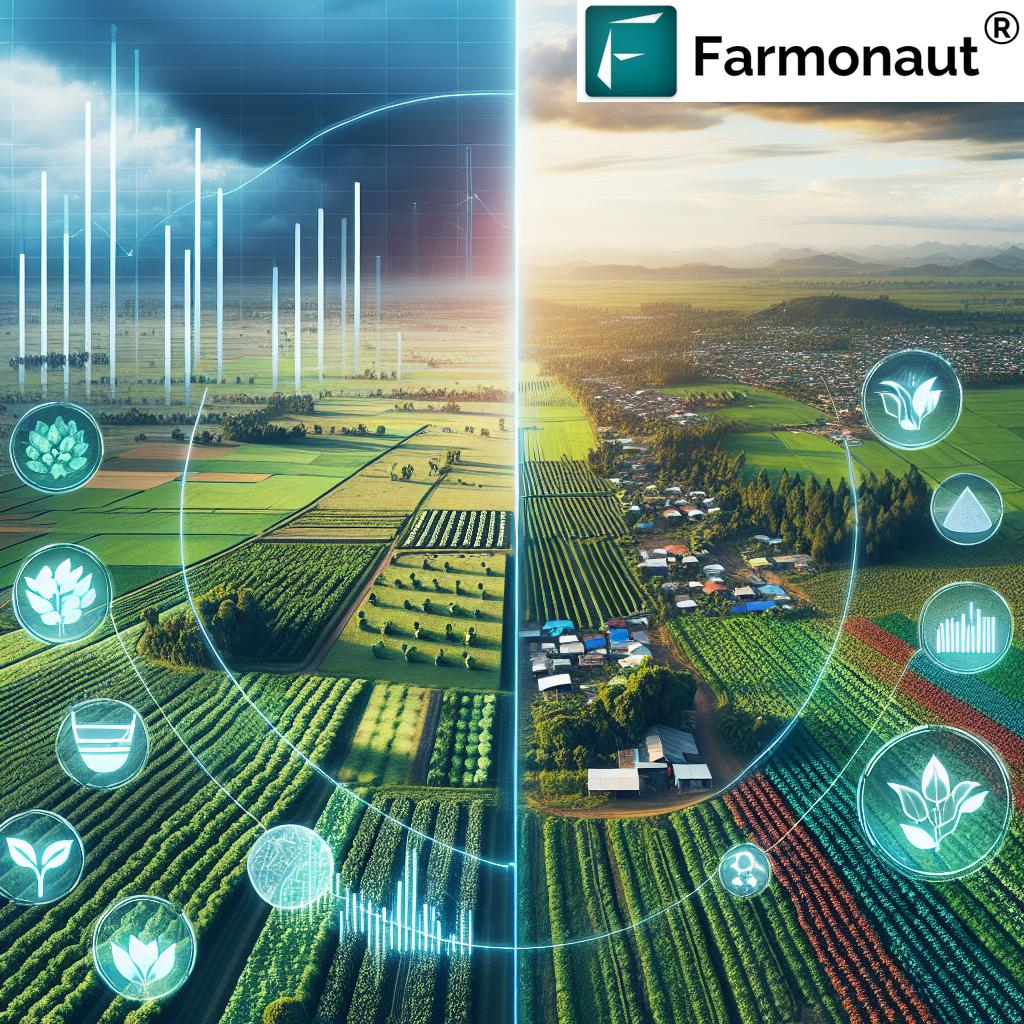Contents
- Introduction & Key Trivia
- Comparative Commodity Price Trend Table
- Corn Futures Price per Bushel Today: Gauging Market Signals
- DAP Price in Bihar Today: Impact on Fertilizer Usage & Crop Productivity
- 1 Kg Potato Price in Bihar Today: Price Trends & Consumer Dynamics
- Interlinkages, Policy Implications & the Future Outlook
- Satellite Technology & Data-Driven Agriculture: Farmonaut’s Role
- Frequently Asked Questions (FAQ)
- Conclusion
“Did you know? Corn futures for 2025 trade above $5.20 per bushel, driving major agri-investment trends in Bihar.”
Corn Futures Price, DAP & 1kg Potato Price Bihar Today: Insights & Trends for 2025
As we step into 2025, understanding corn futures price per bushel today, DAP price in Bihar today, and 1 kg potato price in Bihar today becomes vitally important for everyone in agriculture, from farmers and traders to policy-makers and consumers. These commodity prices not only reflect the current market dynamics but also directly influence farming decisions, input procurement, rural economy vitality, and even the broader food security of a region like Bihar.
In this comprehensive article, we delve into the trends, factors, and implications surrounding these crucial commodities in 2025. You’ll gain a robust understanding of how corn, DAP fertilizer, and potato price trends interact, reflecting both agricultural practices and the current status of rural livelihoods in Bihar and beyond.
With input costs, climate variability, and market access shaping profitability and viability in agriculture, tracking the right price signals is crucial for sound, future-ready farming decisions.
Tip: Get real-time commodity insights, weather-impact assessments, and crop advisory for Bihar using our mobile & web apps, empowering you to plan farming operations more efficiently.
Comparative Commodity Price Trend Table: Corn Futures, DAP, & Potato in Bihar (2025)
Corn Futures Price per Bushel Today: Gauging Market Signals & Farming Decisions
Corn, or maize, is not just a staple cereal grain and vital feed crop; it has become increasingly significant in Bihar’s agricultural landscape. The corn futures price per bushel today serves as a crucial guidepost for both farmers and traders, influencing everything from planting and input usage to post-harvest storage and market choices. Monitoring these price signals helps in making better agri-sector decisions and ensures crop profitability in 2025 and beyond.
Why Corn Futures Price per Bushel Today Matters
- Crop Planning: A higher futures price per bushel for corn often encourages more acreage in Bihar.
- Sales & Storage: Price trends influence when to sell or opt for storage till prices rise.
- Input Procurement: Future price expectations affect input purchase timing (fertilizer, seeds).
The corn futures price per bushel today (around $5.20 in 2025) is shaped by global factors such as climate variability (weather in US, Brazil, China), biofuel policies (like ethanol mandates), and trade relations—all of which make futures prices somewhat volatile and highly sensitive.
Key Factors Influencing Corn Futures Prices in 2025
- Weather and Climate Variability: Drought or floods in key regions lead to substantial price fluctuations.
- International Demand: Indian traders and farmers observe US/China demand for corn.
- Biofuel Policy Shifts: Changes in biofuel blending ratios strongly impact corn demand (as a renewable energy feedstock).
- Global Trade Relations: Tariff updates, export bans, or ROW trends matter.
For farmers in Bihar, a rising corn futures price per bushel today signals potential profitability, thus encouraging increased acreage and better post-harvest storage decisions, especially during the kharif and rabi crop seasons. A downward trend may push farmers to diversify into alternative crops or explore new income sources.
Corn’s Expanding Role in Bihar’s Agriculture
Corn has expanded its acreage in the state owing to its profitability, shorter growing cycle, and resilience to certain climatic adversities. Current corn prices also reflect increased feed demand from livestock and industrial players.
- Corn is a critical feed crop for animal husbandry, poultry, and starch-based industries in Bihar.
- It acts as a hedge for farmers against rice-wheat price volatility.
With competitive futures pricing and strong market signals, corn remains a pivotal commodity shaping agricultural decisions in 2025.
Did you know? Using advanced satellite and AI-driven monitoring, our platform (see above demo) equips farmers and traders with actionable crop health insights and site-specific weather forecasts, supporting their input procurement and harvest timing decisions.
Explore: Our Large-Scale Farm Management solution enables precision farming, multi-field and multi-crop monitoring, and data-backed yield improvement for farm administrators across Bihar.
“In Bihar, DAP fertilizer sells for ₹1,700 per 50kg bag, while 1 kg of potatoes averages ₹20 today.”
DAP Price in Bihar Today: Impact on Fertilizer Usage and Crop Productivity
Diammonium Phosphate (DAP) remains the most commonly used phosphorus fertilizer in Indian agriculture, crucial for crops like corn, wheat, pulses, and more. The DAP price in Bihar today is a significant driver of farm input costs and, therefore, overall crop productivity.
- Phosphorus Role: Essential for root development, grain formation, and flowering.
- Market Impact: Prices determine affordability and actual usage levels amongst farmers.
As of 2025, DAP fertilizer is selling at around ₹1,700 per 50 kg bag in Bihar. While this represents relative price stability due to government subsidy support, any shift in subsidy policy, import costs, or local production can trigger fluctuations and impact availability.
Factors Determining DAP Price in Bihar in 2025
- Government Subsidies: Directly reduce the cost of DAP for farmers.
- Global Phosphate Markets: Raw material pricing and shipping affect domestic rates, especially as a large proportion is imported.
- Exchange Rate Fluctuations: Rupee-dollar changes can push price upward.
- Local Production Initiatives: Eastern India is seeing new fertilizer plants to boost supply and lower transportation costs.
- Policy Interventions: Efforts to streamline supply chain management and input distribution help stabilize prices for Bihar farmers.
Higher DAP prices may discourage farmers from optimal fertilizer usage, negatively affecting soil fertility and yields over time. Conversely, affordability and availability (boosted by rational subsidy, supply chain reforms, or local production) promotes better agricultural productivity and supports rural economy vitality.
Trends in DAP Usage, Distribution & Technology
- Balanced fertilizer application practices promoted by policymakers help prevent soil nutrient imbalances.
- Digitized fertilizer tracking and direct benefit transfer (DBT) in subsidy disbursal increase transparency.
- Emergence of precision agriculture and AI-driven advisory enables farmers to optimize DAP usage at the right dose and timing.
We recommend exploring satellite-based tools for on-farm soil health assessment, which can help you precisely plan fertilizer input needs and usage.
Learn more: See how Carbon Footprinting & Sustainability Solutions can help agricultural professionals in Bihar track, manage, and reduce fertilizer-linked carbon emissions while boosting crop health.
Policy tip: Monitoring and adjusting fertilizer application practices in sync with weather forecasts can maximize fertilizer efficiency and crop yields.
1 Kg Potato Price in Bihar Today: Trends, Storage & Market Dynamics
Potato remains one of the most important commodities in Bihar, a staple crop that directly influences food security, household consumption, and rural incomes. The 1 kg potato price in Bihar today stands at around ₹20 in 2025, but this price is highly seasonal and often volatile due to multiple factors.
- Price Drops: After harvest (January-March) when supply peaks, price may fall below ₹16/kg.
- Price Rise: In lean or off-season months, prices may climb to ₹24-₹26/kg or higher, impacting consumers.
Smallholder farmers in Bihar often struggle with low market price realization during glut months due to limited cold storage access and fragmented supply chains. This significantly affects rural viability while off-season price spikes can strain food budgets.
Key Factors Impacting Potato Prices in Bihar (2025 Onwards)
- Production Output: Influenced by rainfall and weather variability during sowing and growth stages.
- Cold Storage Infrastructure: Determines post-harvest holding capacity; more storage = more steady prices.
- Supply Chain Efficiency: Better logistics and market linkages help stabilize farmer incomes and ensure affordable market pricing throughout the year.
- Policy Initiatives: Incentives for cold storage, contract farming, and cooperative marketing are making a difference.
Trends: Modern Practices & Price Management
- Emergence of contract farming offers farmers better price stability and reduces post-harvest distress sales.
- Investments in cold storage infrastructure are key for reducing losses and enabling more predictable potato pricing.
- Seasonal demand-supply dynamics continue to shape the status of potato prices; bad monsoon years still pose a risk for shortages and price surges.
For those interested in boosting yield per hectare or exploring post-harvest management, consider digital monitoring and advisory to plan irrigation, pest control, and harvest timing. These insights help maximize income and improve nutrition outcomes.
Further reading: Crop Plantation & Advisory Services provide real-time satellite insights, empowering potato producers with site-specific data to maximize productivity.
Discover: With Product Traceability Solutions, ensure full transparency from farm to fork, increasing supply chain trust and reducing the occurrence of counterfeit produce in Bihar’s vegetable markets.
Interlinkages, Policy Implications, and Agricultural Outlook for Bihar (2025+)
The market dynamics of corn, DAP fertilizer, and potato are closely interlinked within Bihar’s agricultural landscape. Here’s how these commodities influence each other and the implications for future farming decisions:
- Crop Planning: Corn futures influence cropping patterns; lucrative corn prices encourage more land allocation.
- Fertilizer Usage: DAP price and availability determine the financial feasibility of fertilizer-intensive crops—a critical factor for farmers’ input procurement.
- Food Security and Incomes: Stable potato prices ensure consumer affordability and rural income viability.
- Weather and Climate Shocks: Disrupt both yield and price, thus requiring better risk management and forecasting tools.
- Policy Synergy: Integration of transparent markets, intelligent fertilizer subsidy allocation, and infrastructure development is crucial for sustainable agricultural growth.
Forward-looking policies for Bihar need to prioritize:
- Transparent Price Discovery: Digital commodity platforms for uniform, real-time pricing data.
- Balanced Fertilizer Subsidy Reform: Data-driven allocation of subsidies and improved input delivery.
- Investment in Storage & Logistics: Expanding cold storage, digital fleet tracking (see Fleet Management), and supply chain digitization.
- Technological Interventions: Empowering farmers, traders, and allied sectors to make better decisions via agri-tech and satellite-based insights.
Leveraging weather and price forecasting, integrated market advisory, and digitized traceability will be a game-changer for Bihar’s agriculture sector in the coming years.
Fleet Management solutions (like those provided by us at Farmonaut) bring efficiency and transparency to agricultural logistics, optimizing vehicle usage, and reducing spoilage during the crucial post-harvest marketing window.
Explore: Easily integrate Farmonaut API to stream satellite and commodity price insights directly into your own ERP or farm management system. Read the API Developer Docs to get started!
Satellite Technology & Data-Driven Agriculture: Farmonaut’s Role
In 2025 and beyond, access to granular, real-time satellite data and AI-driven analytics will be essential for effective commodity price tracking, crop monitoring, and resource optimization. We at Farmonaut are committed to making these insights accessible and affordable for every stakeholder—from smallholder farmers to agricultural businesses and government agencies.
- Satellite Crop Monitoring: Track crop health, soil moisture, and NDVI/biomass indices using multispectral imagery, helping you identify areas needing intervention.
- AI-Driven Advisory: Our Jeevn AI system delivers weather forecasts, input advisory for fertilizer (including DAP), and custom crop management tips at field level.
- Blockchain Traceability: Ensure end-to-end commodity traceability for better food safety, supply chain authenticity, and reduced fraud across Bihar and India.
- Integrated Resource & Fleet Management: Optimize field logistics, reduce costs, and improve crop-to-market efficiency.
- Environmental Impact Tracking: Get real-time data on carbon footprint for agriculture, supporting compliance and sustainability goals.
All these solutions are delivered securely via mobile, web app, and API, increasing reach and affordability for every user—be it individuals, enterprises, or public sector agencies. With Farmonaut subscriptions, you unlock scalable access to advanced agri data and insights that help you thrive in the modern rural economy.
Unlock: Start today with Farmonaut subscriptions to access India’s leading satellite-driven agricultural decision support tools.
Frequently Asked Questions (FAQ)
What is the corn futures price per bushel today and its impact for Bihar farmers?
The corn futures price per bushel today is approximately $5.20 for 2025. It acts as a market signal for Bihar farmers, influencing acreage decisions, input purchase timing, and storage or sale strategies. A higher futures price typically encourages more corn cultivation due to increased expected profitability.
How does DAP price in Bihar today affect fertilizer usage and crop yields?
The DAP price in Bihar today is about ₹1,700 per 50kg bag in 2025. When DAP is affordable and accessible, farmers use optimal fertilizer doses, maximizing yields and maintaining soil fertility. Higher prices or shortages reduce fertilizer usage, risking lower productivity and future soil health.
Why is the price of 1 kg potato in Bihar so volatile?
Potato prices in Bihar see seasonal fluctuations due to harvest cycles, weather conditions, production volume, and cold storage infrastructure. Prices are lowest at harvest, rising in lean months when stored stocks and new supply decline.
How can Bihar farmers reduce market price risks?
- Monitor commodity price trends (using updated apps or digital tools)
- Diversify cropping patterns (choose between corn, wheat, pulses, potato, etc.)
- Invest in or access cold storage for extended post-harvest holding
- Use AI and satellite advisory for better planning
- Follow government updates on subsidy and minimum support price (MSP)
How does Farmonaut help in informed farming decisions and reducing input costs?
We at Farmonaut provide satellite monitoring and AI-powered advisory for crop health, soil moisture, weather forecasts, and input optimization. This helps in reducing unnecessary fertilizer use, improving yield, and saving on input costs for farmers across Bihar.
Are there affordable tools for monitoring carbon footprint, traceability, or crop health?
Yes, discover carbon footprint tracking, traceability solutions, and satellite-supported loan/insurance verification on the Farmonaut platform.
Conclusion: Steering Bihar Agriculture Towards Resilience & Prosperity
In 2025 and beyond, tracking corn futures price per bushel today, DAP price in Bihar today, and 1 kg potato price in Bihar today is essential for anyone invested in Bihar’s agriculture and rural economy. These price signals not only reflect the current dynamics of supply, demand, and weather but also guide critical decisions for farmers, traders, and policy-makers.
- Stay alert to global and local market trends that can impact policy, profitability, and long-term food security.
- Embrace technology-driven insights—satellite monitoring, mobile apps, and digital traceability— for smarter, faster, and more resilient farming decisions.
- Actively participate in government, cooperative, and industry programs for better lower-cost input access, post-harvest infrastructure, and market diversification.
By proactively understanding commodity price trends and using digital tools, Bihar and similar agri-driven regions can strengthen their agricultural viability—benefiting all stakeholders in the chain, from field to fork.
Looking ahead? Use real-time price, weather, and crop health intelligence to gain a competitive edge in agriculture. Bihar’s growth story in 2025 will be shaped by those who read these price signals early and act with data-driven confidence.













